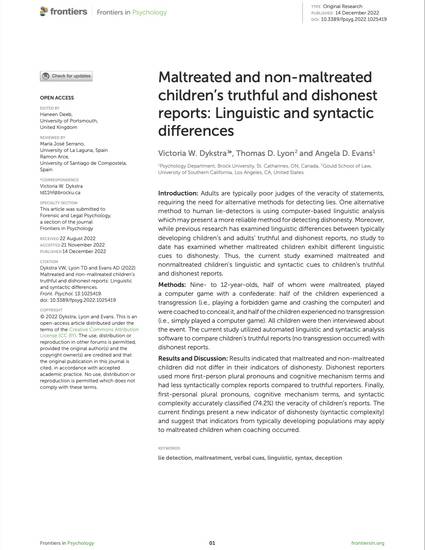
Article
100. Maltreated and non-maltreated children’s truthful and dishonest reports: Linguistic and syntactic differences.
Frontiers in Psychology
(2022)
Abstract
Adults are typically poor judges of the veracity of statements, requiring the need for alternative methods for detecting lies. One alternative method to human lie-detectors is using computer-based linguistic analysis which may present a more reliable method for detecting dishonesty. Moreover, while previous research has examined linguistic differences between typically developing children and adults truthful and dishonest reports, no study to date has examined whether maltreated children exhibit different linguistic cues to dishonesty. Thus, the current study examined maltreated and non-maltreated children’s linguistic and syntactic cues to children’s truthful and dishonest reports. Nine- to 12-year-olds, half of whom were maltreated, played a computer game with a confederate: half of the children experienced a transgression (i.e., playing a forbidden game and crashing the computer) and were coached to conceal it, and half of the children experienced no transgression (i.e., simply played a computer game). All children were then interviewed about the event. The current study utilized automated linguistic and syntactic analysis software to compare children’s truthful reports (no transgression occurred) with dishonest reports. Results indicated that maltreated and non-maltreated children did not differ in their indicators of dishonesty. Dishonest reporters used more first-person plural pronouns and cognitive mechanism terms and had less syntactically complex reports compared to truthful reports. Finally, first-personal plural pronouns, cognitive mechanism terms, and syntactic complexity accurately classified (74.2%) the veracity of children’s reports. The current findings present a new indicator of dishonesty (syntactic complexity) and suggest that indicators from typically developing populations may apply to maltreated children when coaching occurred.
Keywords
- lie detection,
- linguistic cues,
- child abuse,
- child sexual abuse,
- forensic interviewing
Disciplines
Publication Date
Fall December 14, 2022
Citation Information
Dykstra, V., Lyon, T.D., & Evans, A.D. (2022). Maltreated and non-maltreated children’s truthful and dishonest reports: Linguistic and syntactic differences. Frontiers in Psychology, 13, 1025419. doi: 10.3389/fpsyg.2022.1025419
